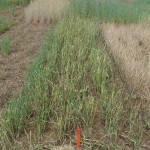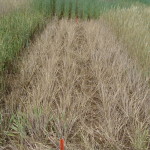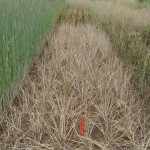
Some reports of ineffective burndown applications to winter annual cover crops (winter wheat, cereal rye, hairy vetch, crimson clover, etc.) have been coming in. Even in our research at the West Tennessee Research and Education Center cover crops have proven difficult to control with a single pass of the sprayer. Paraquat and glyphosate are the typical go-to herbicides for this type of burndown application, but neither has proven consistently effective this spring.
The lack of consistency with these herbicides could be due to this spring’s cool-damp weather, lack of adequate coverage needed to penetrate thick residues, robust cover crop growth or a little bit of all three. We have been evaluating the effectiveness of these herbicides in controlling winter wheat, cereal rye, hairy vetch, and crimson clover since the beginning of March. Applying glyphosate (32 fl oz/A) or paraquat (48 fl oz/A + 0.25% NIS) alone has provided inconsistent control (15% – 75%) of all the evaluated species. Glyphosate provided better control of the two, as paraquat only burned the foliage back and growth later continued. Since this was the case, we decided to switch gears to see if tank-mixing a Photosystem II inhibitor with paraquat or adding dicamba to glyphosate would increase effectiveness of the two non-selective herbicide options. As it turned out, both tank-mixes increased effectiveness.
Metribuzin (5 oz/A) was added to paraquat (48 fl oz/A + 0.25% NIS) and resulted in greater than 90% control of all cover crop species. Dicamba (8 fl oz/A) was added to glyphosate (32 fl oz/A) and increased control of both broadleaf species to greater than 80%, but added little to the control of the grass species. Therefore, adding a Photosystem II inhibitor to paraquat is the best choice that we have evaluated this year to control winter annual cover crops. Photosystem II options include atrazine for corn, metribuzin for soybean, and fluometuron for cotton. However, it will take 10 – 14 days to achieve complete burndown to attain good seed-soil contact. Moving forward, the warmer weather in the upcoming week suggests that the planters will be headed to the field in full swing. So if you haven’t terminated your cover crops yet, it is definitely time.



